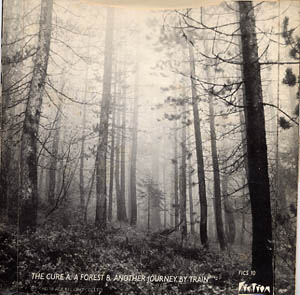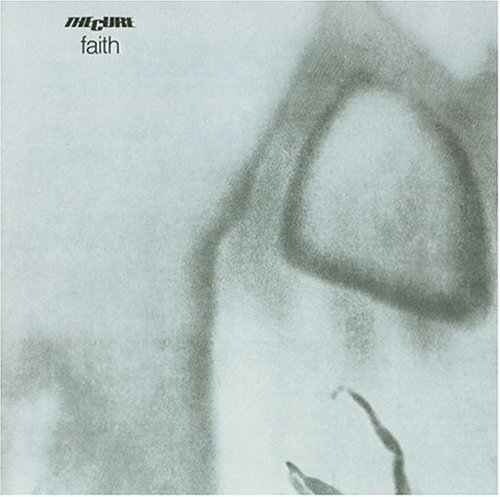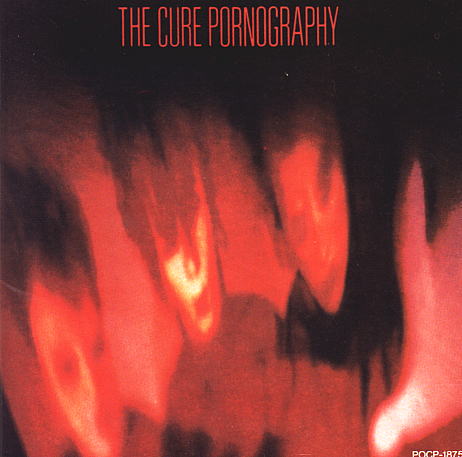August 03, 2005
IT DOESN'T MATTER IF WE ALL DIE: THE CURE'S UNHOLY TRINITY

'Goth took hold as both a suburban and provincial cult, in which young men and women with heavily powdered faces, mourning clothes and Robert Smith's hairstyle could be seen at domestic ease in towns like Littlehampton and Ipswich.' – Michael Bracewell, England is Mine, 119-120
Any discussion of Goth will remain incomplete if it doesn't deal with The Cure.
Goth and the suburbs enjoy a peculiar intimacy (no-one knows this more than Tim Burton, whose Edward Scissorhands brilliantly laced the Avon scent of the suburbs with the perfume from Goth’s flowers of romance), and is there a group more suburban than The Cure? In England is Mine, Michael Bracewell made much of their origins in humble Crawley. ‘'Quiet and respectable, yet lacking the bourgeois superiority of nearby Haywards Heath (home of Suede), Crawley is a near perfect example of England at its least surprising,” (115) he wrote. For Bracewell, the group are the sound of the in-between spaces of English culture: the suburbs, yes, but also, adolescence, the suburbia of the soul. The Cure are the personification of the not-quite and the not-yet: not quite execrated but never really respected; not punk veterans but not yet generic Goff. The suspicion that has dogged them is that of fakery; yet inauthenticity – as existential condition – was The Cure’s stock-in-trade. You can hear it all in the grain of Robert Smith’s voice. Bracewell again: 'When Smith sang, it wasn't so much his doom-laden lyrics as the actual sound of his voice which lent the Cure their mesmeric monotony: it was the voice of nervous boredom in a small town bedroom, muffled beneath suffocating layers of ennui. Alternately peevish and petulant, breathless with anguish or spluttering with incoherent rage, Smith's voice was unique in making monotony malleable.' (117)
There is a period, a moment, when groups become what they are. Everything that has come before is preparation and rehearsal; everything that comes after is either decline or evasion. Roxy were themselves immediately – the band-brand established with the first notes of ‘Remake, Remodel’ (with the result that Ferry’s subsequent career has been a long essay in disappointment and deferred return), but it’s more usual for a group to take a while to find themselves; to emerge gradually from a cocoon of allusion, homage and plagiarism. It wasn’t quite like that with The Cure, whose best work was always produced in negotiation with their influences.
Their early mode - a spidery, punk-spiked pub sub-psychedelia – now sounds like a series of thin sketches. The Cure become themselves in that moment –lasting three albums - after they have shed the petulant quirkiness of Three Imaginary Boys but before they have entered the comfort zone of branded recognizability. By then, Smith’s panto-persona – lipstick smear, warm beer and Edward Lear – had become an archetype in the semiotic cemetery of the student disco, and the parameters of The Cure’s style were well-established – marked by what quickly became a regular oscillation between a post-Seargent Pepper jollity and a slippers-comfortable despair. All of the drama of faltering self-discovery and existential experimentalism that makes the essential triptych of Seventeen Seconds, Faith and Pornography so compelling has gone.
The Cure’s three crucial albums emerged from the shadow of two other bands, whose reputation towered above theirs: The Banshees and Joy Division. Smith made no secret of his fixation on The Banshees (with whom he would later guest as a guitarist). When the band’s first bassist, Michael Dempsey, left the band, it was because he “wanted us to be XTC part 2,” whereas Smith “wanted us to be the Banshees part 2.”
Robert Smith’s look - that clown-faced Caligari ragdoll – was a male complement to Siouxsie’s. And as with Siouxsie’s, Smith’s bird’s nest backcomb, alabaster-white face powder, kohl-like eyeliner and badly applied lipstick is easily copied; a kit to be readily assembled in any suburban bedroom. It was a mask of morbidity, a sign that its wearer preferred fixation and obsession above ‘well-rounded personhood’.
Goth morbidity arose in part from a Schopenhauerian scorn for organic life: from Goth’s perspective, death was the truth of sexuality. Sexuality was what the ceaseless cycle of birth-reproduction-death (as icily surveyed by Siouxsie on Dreamhouse’s ‘Circle Line’) needed in order to perpetuate itself. Death was simultaneously outside this circuit and what it was really about. Affirming sexuality meant affirming the world, whereas Goth set itself, in Houllebecq’s marvelous phrase, against the world and against life. By the early eighties, it was possible to posit a rock anti-tradition that had similar affiliations, an anhedonic, anti-vital rock lineage that began with The Stones – with the neurasthenic Jagger of ‘Paint it Black’ rather than the cloven-hooved demonic-Dionysus of ‘Sympathy for the Devil’ - and passed through the Stooges and the Pistols, before reaching its nadir-as-zenith in Joy Division. But Goth suspected that rock was that always and essentially a death trip. This was the gambit of The Birthday Party, who hunted rock’s mythology back to the fetid, voodoo-stalked crossroads and swamplands of the delta blues. After all, isn’t Blues the clearest possible demonstration of the discrepancy between desire and enjoyment, and therefore of the validity of the theory of the death drive? The Blues juju – or jou-jou – relies upon the enjoyment of desires that cannot be satisfied.

While the Birthday Party literalized the return to the Blues – their career a kind of hectic rewind of rock history, beginning with Pere Ubu/ Pop Group modernism and ending in a feverish re-imagining of Blues - The Cure, like the Banshees went to the other extreme. Maintaining fidelity to post-punk’s modernist imperative (novelty or nothing), they preferred a sound that was ethereal rather than earthy, artificial rather than visceral. You can hear this in Smith’s guitar, which, swathed in phasing and flange, destubtantialized and emasculated, aspires to be pure FX denuded of any rock attack. (Is this the first step towards MBV’s honeyed amorphousness?) The Cure’s version of Blues enjoyment-in-the-frustration-of-desire is auditioned in ‘A Forest’: the song in which the group find themselves, ironically, since it is a song about loss – or rather about an encounter with what can never be possessed. ‘The girl was never there’, Smith sings, a line worthy of Scritti – or Lacan. ‘Running towards nothing…. Again and again and again….’, Smith --- a suburban Scotty seeking his Madeleine --- pursues the desire-chimera, the petit objet a, through a dreamscape vividly sound-painted by oneiric synthesizers, drum-machines and Smith’s FX-saturated guitar. ‘A Forest’ was the trailer for Seventeen Seconds, and it turned out to be the album’s centerpiece. The synthesizers and the drum machine bring a moderne sheen lacking on the no-frills hustle and bustle of Three Imaginary Boys. Smith was listening to Astral Weeks, Hendrix, Nick Drake, Bowie’s Low, and wanted the album to be a synthesis of the four. The result was both more and less than this. As English as The Smiths would be, but, naturally, much more modernist and much less kitchen sink, Seventeen Seconds puts one in mind of a deserted country house, vast white spaces and empty floorboards decorated by the ornate cobwebs of Smith’s guitar. Emotionally, the effervescent petulance of the first album has drained away, but, even if the predominant mood is now moroseness, it is not yet Goth- morbid. But there is a kind of cultivated detachment, Smith assuming an ‘ostentatious absenteeism’, dissociating himself from an everyday life conceived of as a dramaturgy of effigies: ‘it’s just your part/ in the play/ for today…’

“I was 21,” Smith told Uncut in 2000, “but I felt really old. I actually felt older than I do now. I had absolutely no hope for the future. I felt life was pointless. I had no faith in anything. I just didn’t see there was much point in continuing with life. In the next two years, I genuinely felt that I wasn’t going to be alive for much longer. I tried particularly hard to make sure I wasn’t.” From its very first moments, Faith locks onto this hollow-eyed bleakness, and stays there. Affectively, the album is as improbably unwavering as Unknown Pleasures and Closer, and the Joy Division (anxiety of) influence hung over Faith like an acrid pall, the black source of its paradoxically entropic energy, what made it possible but also what would relegate it to the status of a revenant. “The whole thing was reinforced by the fact that Ian Curtis had killed himself,” Smith recalled in the Uncut interview, speaking for the post Joy Division generation (which would of course include New Order) that would deem itself inauthentic simply by dint of the fact that it had carried on living. “I knew that The Cure were considered fake in comparison, and it suddenly dawned on me that to make this album convincing I would have to kill myself. If I wanted people to accept what we were doing, I was going to have to take the ultimate step.”

Yet Faith would have benefited from pursuing its emotional mono-tone even more assiduously, if what adrenaline that remained had been drained away, and the two up-tempo tracks (‘Primary’ and ‘Doubt’) had been excised. On all the other tracks, Faith flatlines pop, bringing it as close to complete stillness as it is possible to be without coming to the grinding halt the group had sang of in an earlier, much more fleet-of-foot incarnation. There was no calmness in Faith’s stillness. It is not tranquil, but tranquilized, downer-heavy; not so much oceanic as waterlogged, swamped. (In fact, Faith was recorded on coke, not tranquillizers). The album seems to come from another planet where gravity is more powerful. The synthesizers, now foregrounded more than ever, do most to produce this effect of viscous heaviness. They have a cold warmth that fills out the sound like valium entering the bloodstream. With Faith, as with downers, it is as if the edge has been taken off. Its world is without angles, a fug, fog of bleary drear. It lacks the clinical quality of Joy Division; this is not the sound of depression, nor (as with Movement) of post-traumatic stress but of a kind of total fatalism, in which nothing much matters, where ‘all cats are grey’. Faith finds a strange exhilaration in yielding all hope, in playing dead while going through the zombie motions, ‘breathing like the drowning man’. Bracewell’s description of The Cure’s sound is nowhere more appropriate than when applied to Faith. 'There is no insight or polemic: there are no messages and no rallying anthems. Rather, the Cure are the musical expression of suburbia itself: a dense and repetitious sound, carrying a mesmeric dirge of infinitely transferable sounds, all of which sound as though they could go on for ever - like endless avenues, crescents and drives.' (115-116) Faith’s tracks are distended, hynoptic (or hypnagogic) in their repetitiousness, Smith’s mope a wraith that drifts in after introductions that typically last for ninety seconds or two minutes. Go through the mirror with Smith and what the uninitiated hear as directionless dirges become addictive plateaus, gentle blizzards you enjoy losing yourself in.
After this, you would expect recovery and return, a compensatory uplift. But in the event The Cure’s season in hell was far from over and Pornography outdoes even Faith for morbid enervation. But Faith’s amorphousness is replaced by a newly jagged abrasion and a jittery rhythmic urgency that was The Cure’s take on the then fashionable tribal sound. Its template seems to be the less synthesizer-heavy, more metallic-brutalist tracks on Closer (‘Atrocity Exhibition’, ‘Colony’); the cavernous hollow spaces of PiL; the dancing in the ruins urban anomie of Killing Joke. In the end, it sounds like ‘Flowers of Romance’ sung by a neurasthenic rather than a hysteric, Killing Joke fed on bad trip acid and downers, a defunked 23 Skidoo, all at once.

The opener, ‘100 Years’, is The Cure’s masterpiece. It starts as it means to go on, Smith intoning, “It doesn’t matter if we all die’, an invitation even more forbidding than that leered by the circus barker Curtis on ‘The Atrocity Exhibition’ (‘This is way step inside…’) Like Joy Division’s ‘Disorder’, ‘100 Years’ seems to lift its head from morbid self-absorption to gaze at the world – its words a Cold War ticker-tape as filtered through an adolescent nervous system in the midst of breakdown - but in reality it only selects for consideration those things which confirm its hypothesis that cosmic despair is the only justifiable attitude. ‘Ambition in the back of a black car…. Sharing the world with slaughtered pigs… The soldiers close in….’ Smith comes on like Bowie’s Newton in the most famous scene of The Man Who Fell to Earth, entranced and stupefied by a bank of television screens, all of them bringing bad news. What makes this exhilarating rather than emiserating is the necrotic urgency of the death-disco drum machine and Smith’s guitar riff, which blazes like a distress flare in light polluted sky.

If Smith’s guitar on Pornography often sounds Eastern, it calls up a fantasmatic East in which all of the hippie dreams of free-your-mind exotica have been napalmed into oblivion. Pornography was famously recorded on LSD washed down by alcohol (the band would skulk in a pub waiting for the effects of the acid to wear off before they went into the studio) but it is psychedelic in the same way that Apocalypse Now is. (There are grounds for claiming that Apocalypse Now - with its warporn media overload, its schizophrenic delirium, its sense that The End is only minutes away - was the postpunk film; 23 Skidoo, for one, seemed to have emerged fully-formed from its vision.) Pornography’s delirium is a Jacob’s Ladder bad trip, a psychic Indochina fever dreamt in a Crawley bedroom, the hallucinogens giving distended and distorted shape to anxieties conjured from the suburban heart of darkness.
Smith's lyrics shred sense for the sake of image-impact. He has always been a 'purveyor of filmic ambience' (Bracewell), and the songs on Pornography convey mood through striking images ('voodoo smile... siamese twins') that never cohere into any clear meaning. The album is the Goth equivalent of a chocolate box: an exercise in sheer morbid indulgence unleavened by any cheer.
At the end of the title track, a howling grind that sounds like Joy Division 'The Atrocity Exhibition' spliced with Stockhausen's Hymnen, Smith seeks redemption. ‘I must fight this sickness…. Find a cure….’ But the sickness, the sickness was the most interesting thing about The Cure.
Posted by mark at August 3, 2005 04:00 PM | TrackBack